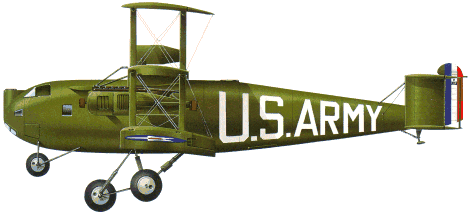 |
Witteman-Lewis NBL-1 Barling Bomber1923 |  |
| BOMBER | Virtual Aircraft Museum / USA / Witteman-Lewis |
 |
The Witteman-Lewis XNBL-1 "Barling Bomber" was an experimental long-range heavy bomber built for the United States Army Air Service in the early 1920s. Although unsuccessful as a bomber, it was an early attempt at creating a strategic bomber. The XNBL-1 (Experimental Night Bomber, Long Range) was designed by Walter Barling, who had previously designed the Tarrant Tabor, which was similar in concept but was destroyed in a fatal crash on its first flight in 1919. Like the Tabor, the Barling Bomber was a large six-engined triplane with a cigar-shaped fuselage. Unlike its predecessor, the XNBL-1 had a crew of seven and had all of its engines mounted level with the fuselage. The undercarriage had ten wheels, including two wheels towards the front of the aircraft (to prevent a nose-over on takeoff) and a tail skid. Components of the aircraft were assembled together to begin flight testing at Wilbur Wright Field. Final cost of the XNBL-1 project was $525,000, not including a $700,000 hangar to house the airplane. Although capable of carrying a 2268kg bomb load, performance was disappointing. A fully-loaded XNBL-1 had a range of only about 275km with a top speed of 155km/h. In contrast, the "short-range" Martin NBS-1 had a range of about 725km and could carry a 907kg at the same speed. On a flight from Dayton, Ohio to Washington, DC, the Barling Bomber failed to fly over the Appalachian Mountains and had to turn around. Although the XNBL-1 was not put into production, it had advanced features such as aluminum fuselage components, adjustable multiwheel undercarriage, separate compartments for crew, a flight engineer, electrical instruments, and advanced engine controls. The XNBL-1 was the largest aircraft in the United States until the Boeing XB-15 in 1935. FACTS AND FIGURES © Armament consisted of seven 7.5mm machine guns on flexible mountings. © The pilots had a semi-enclosed cockpit with several side windows, but the position of the forward gunner's position largely blocked the view ahead. © The many struts and bracing wires created interference drag which contributed to the XNBL-1's stately progress. © The main landing gear had 10 wheels. The forward pair were mainly there to prevent a nose-over. © The incidence of the tailplane could be adjusted in flight using a lever in the cockpit.

|  All the World's Rotorcraft | ||||||||||||||||||||||||||||||||||||||||||||||||||||||||||||
 |

|

20
reply